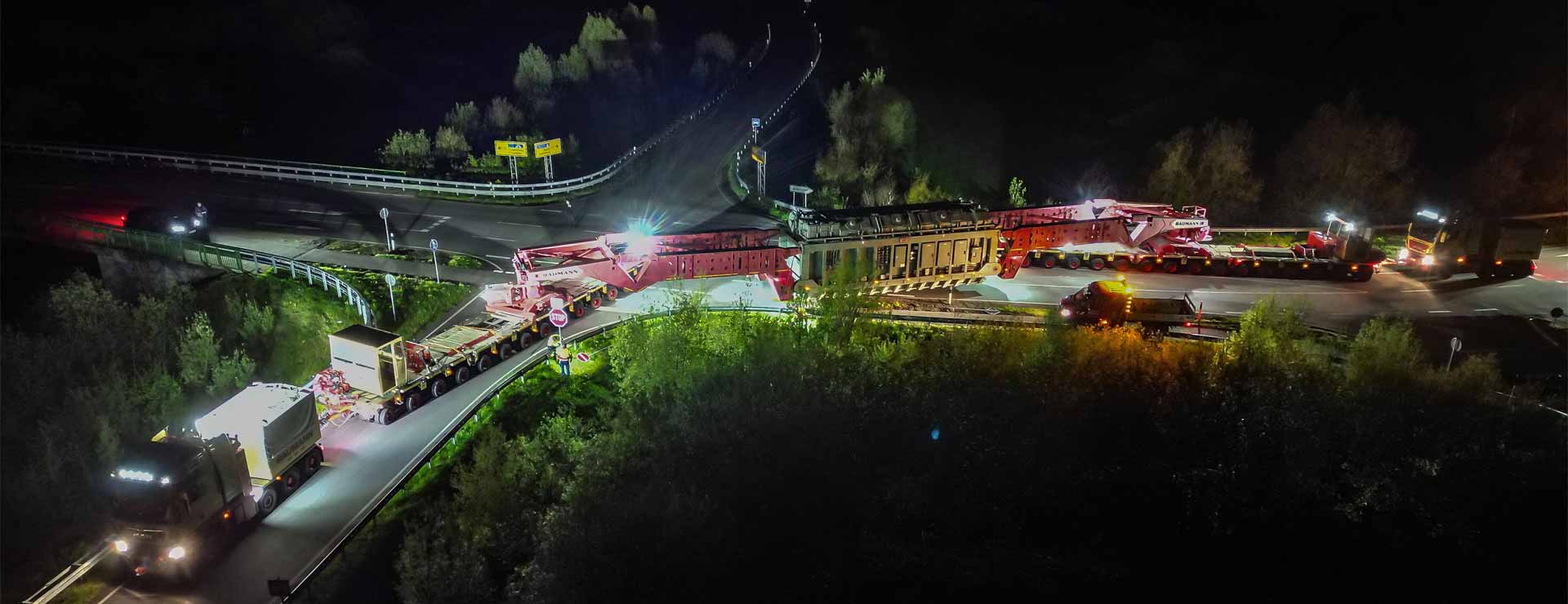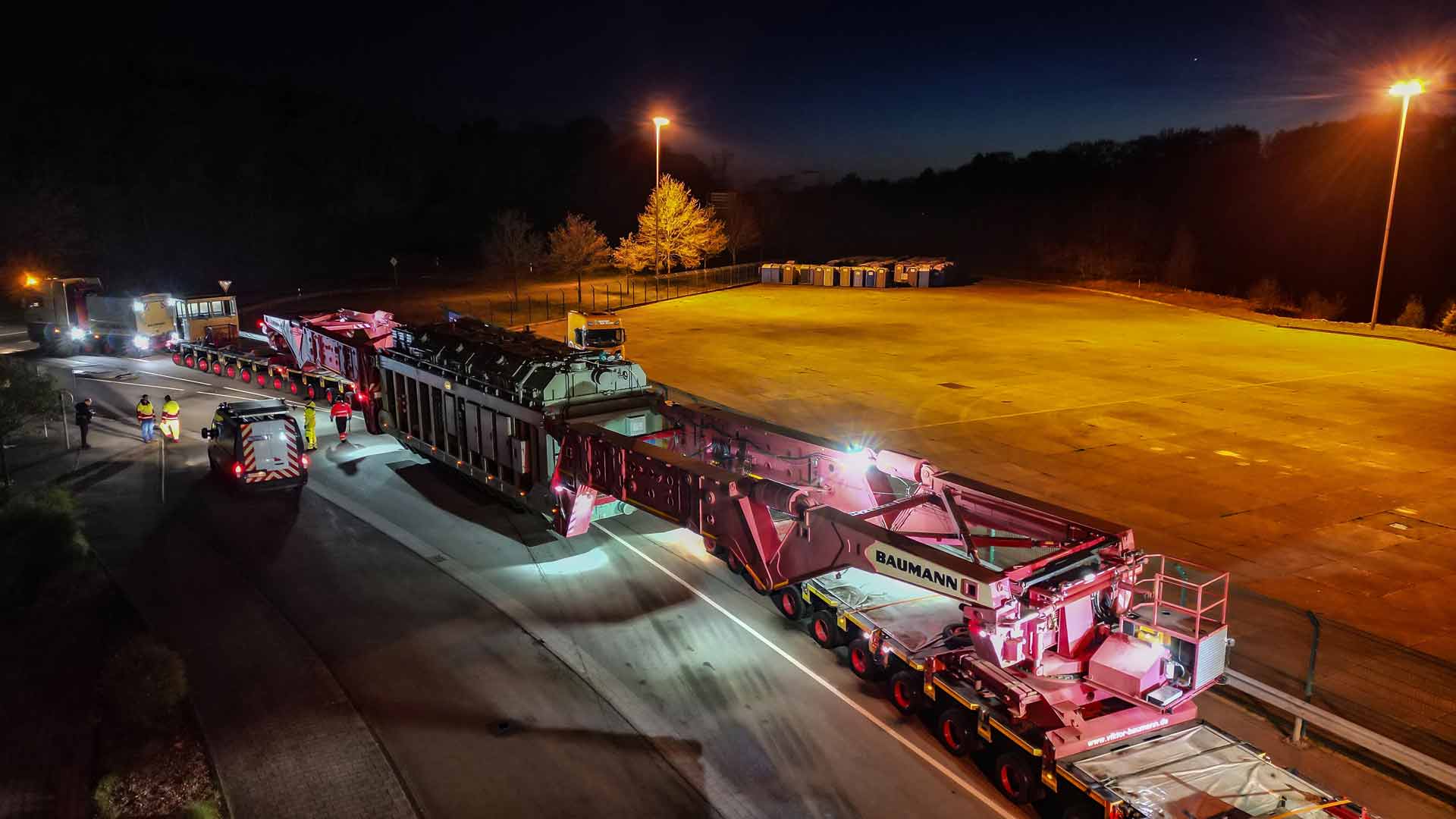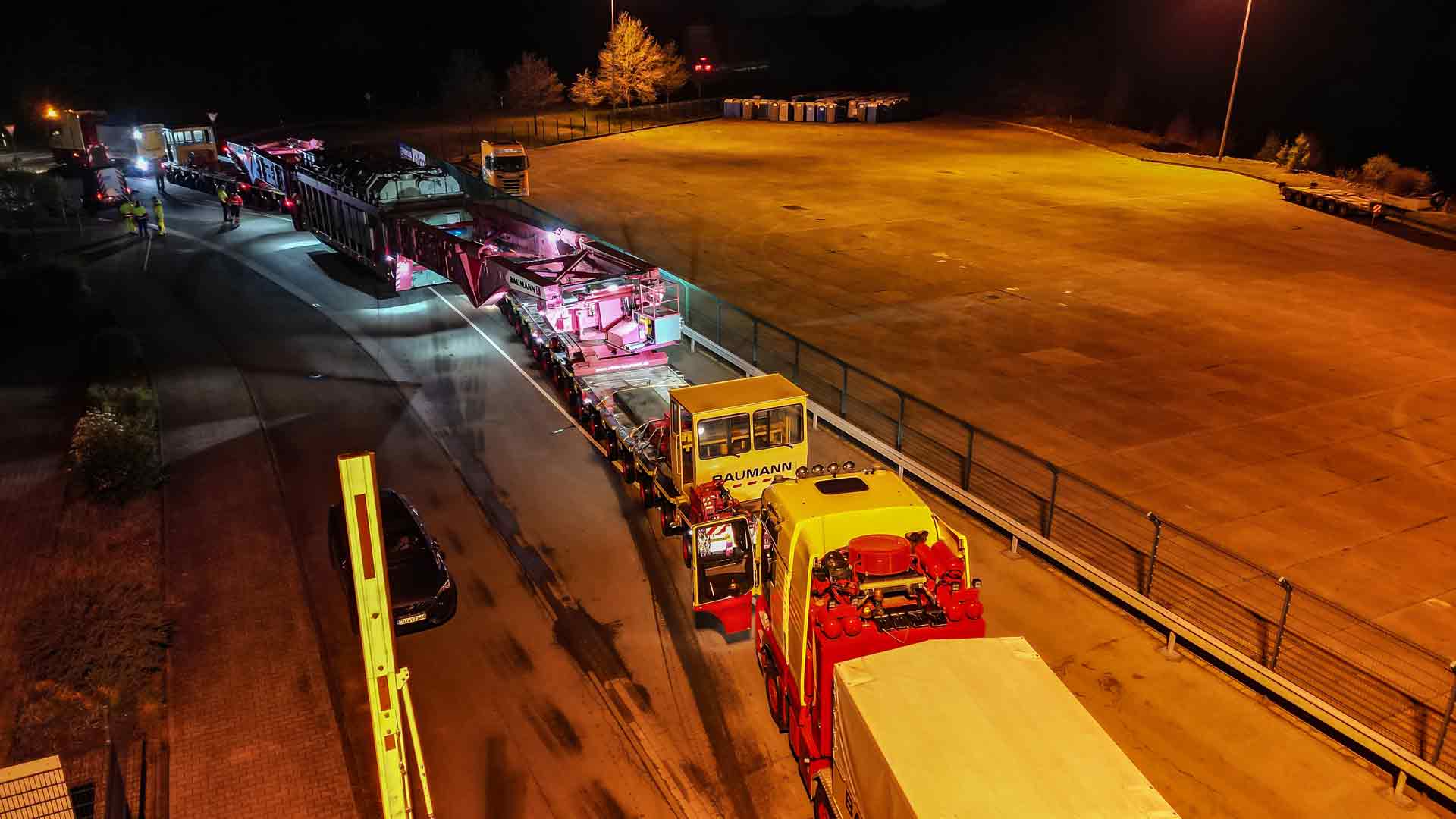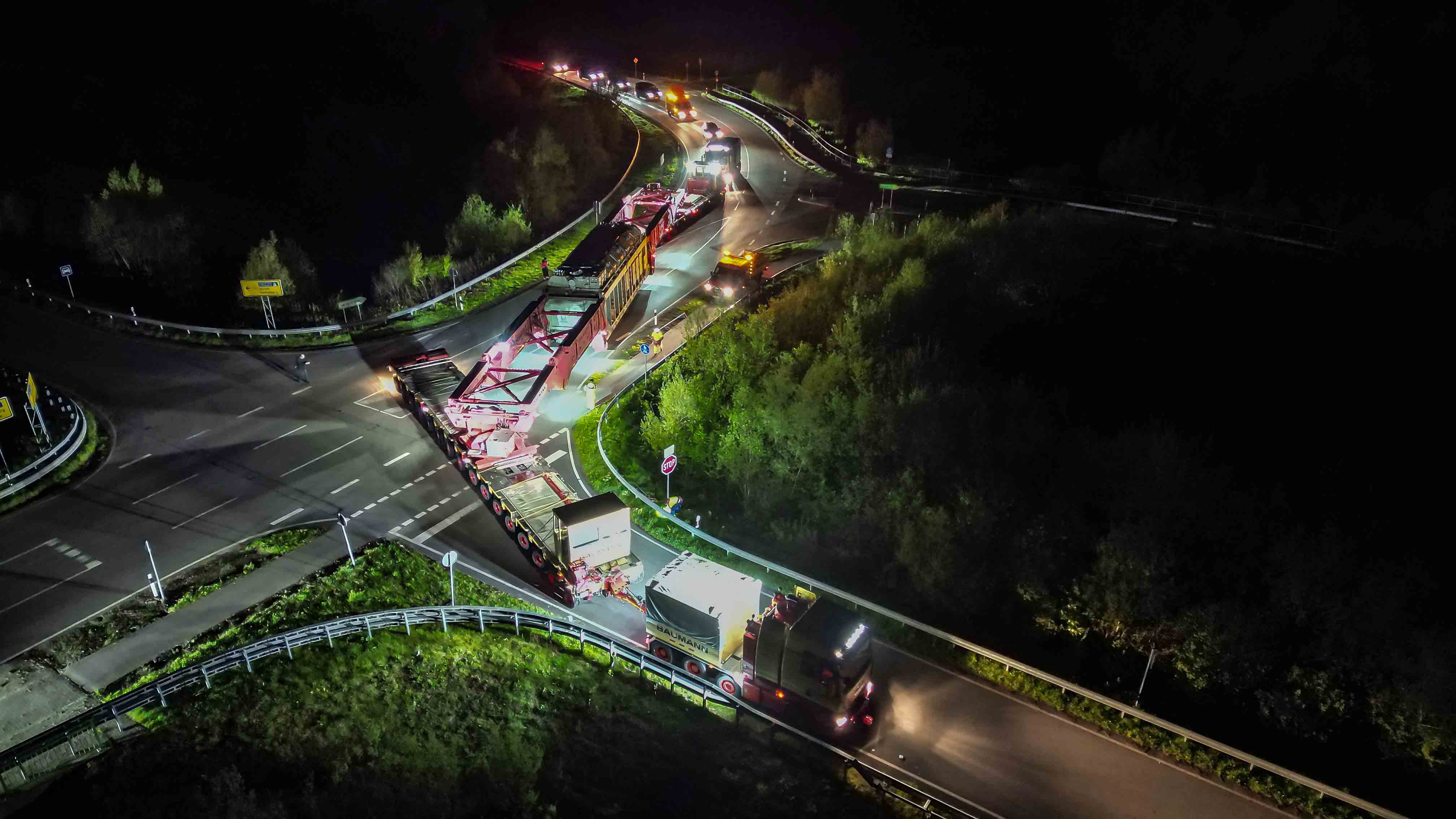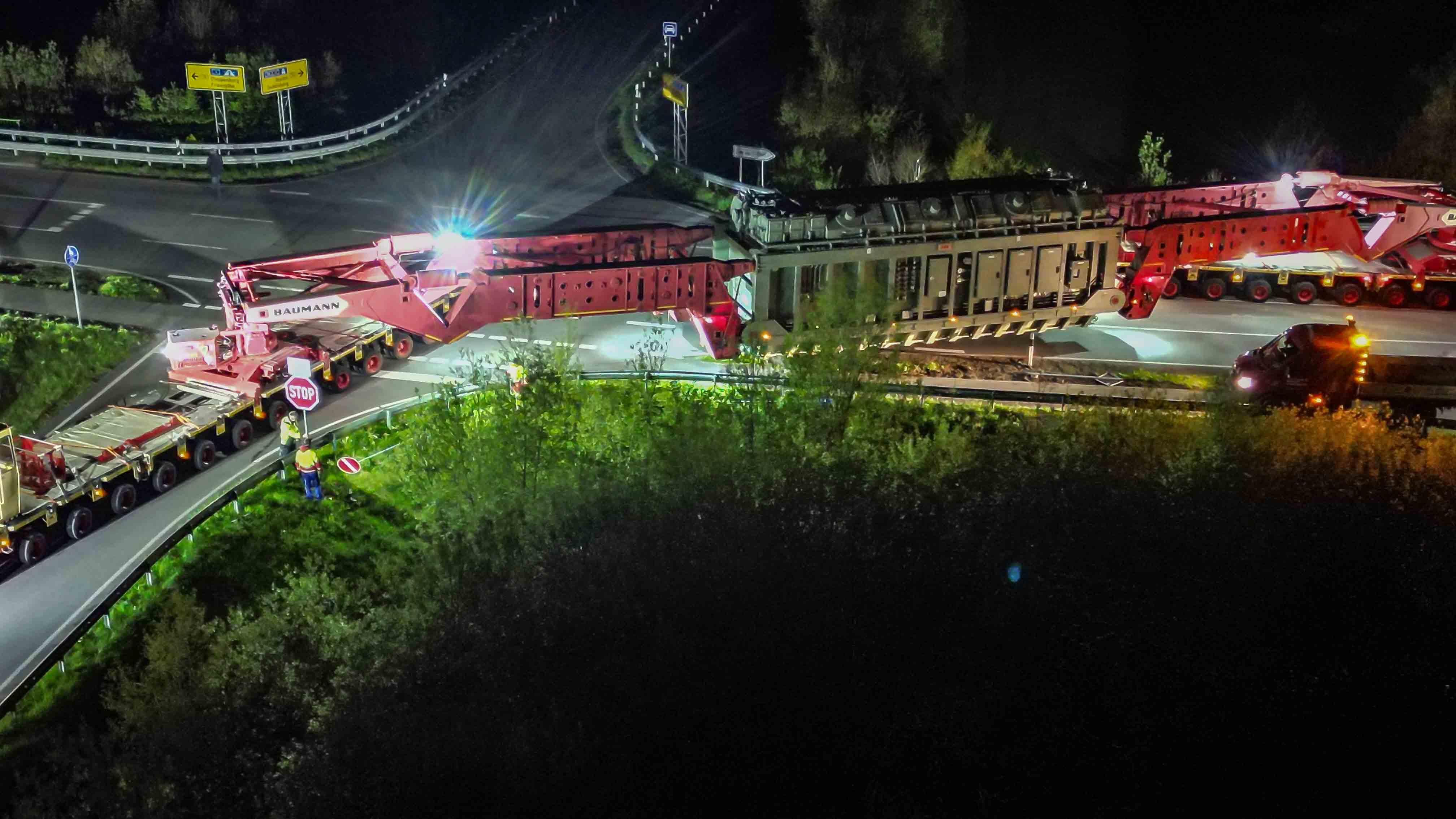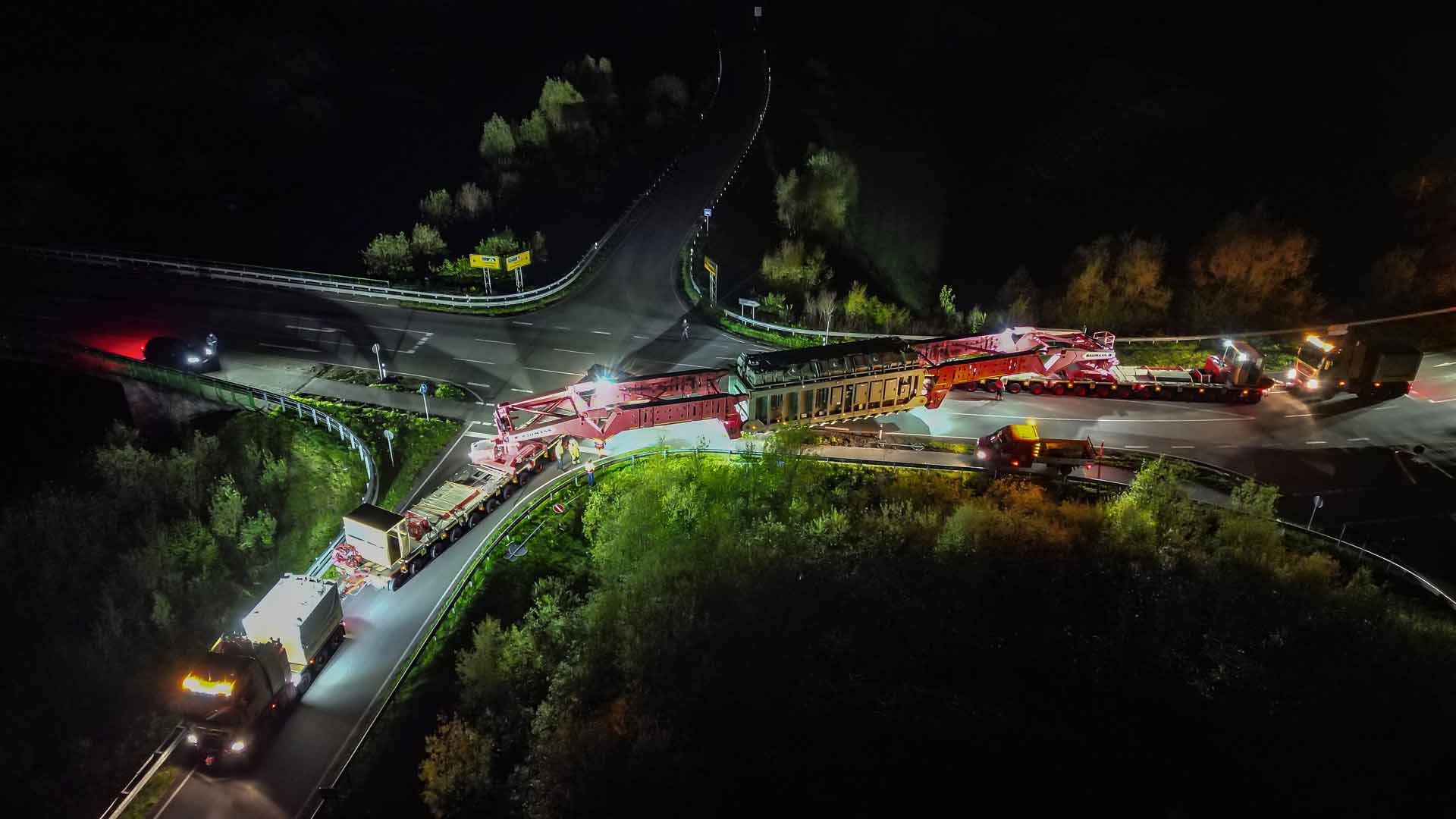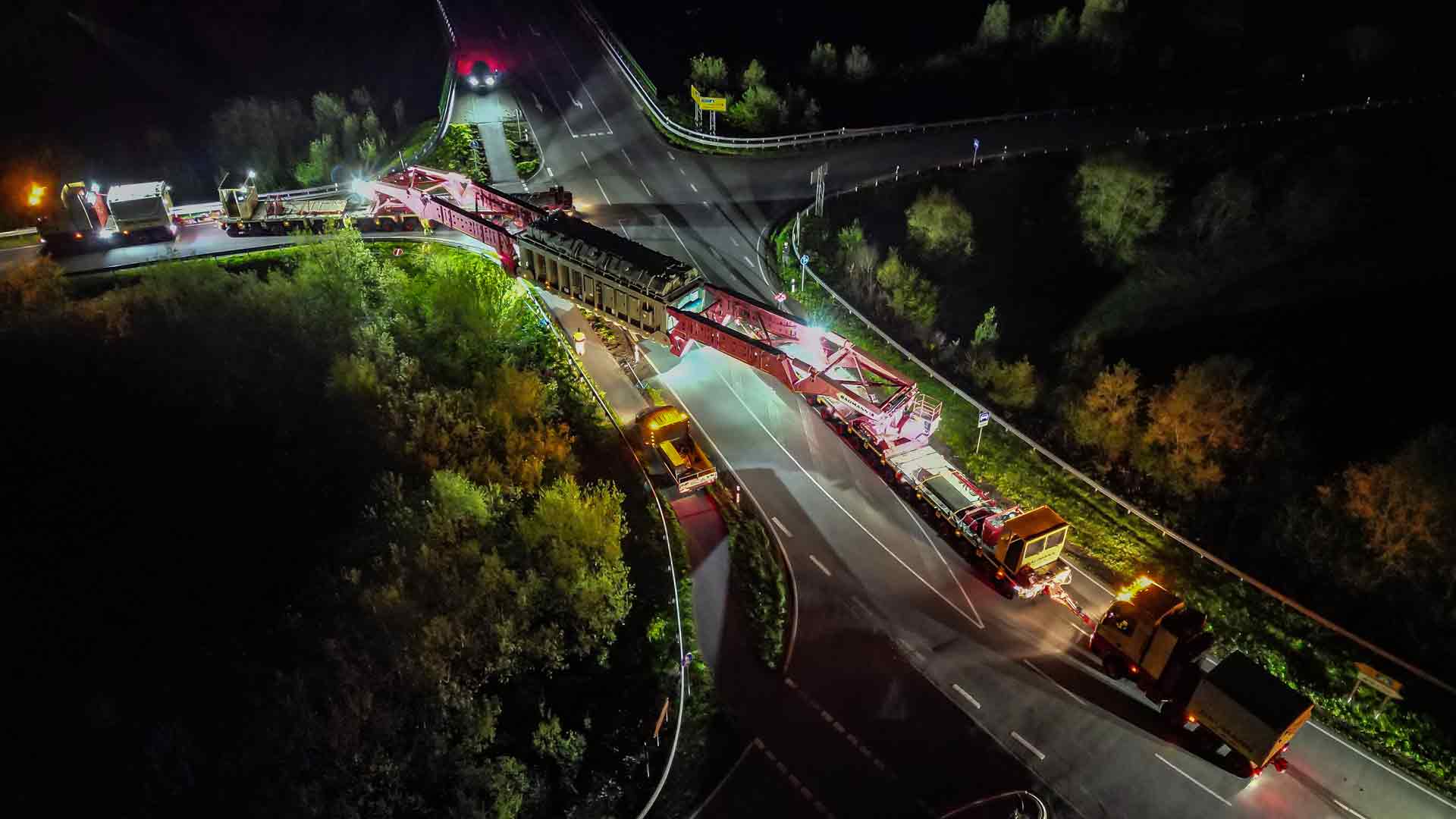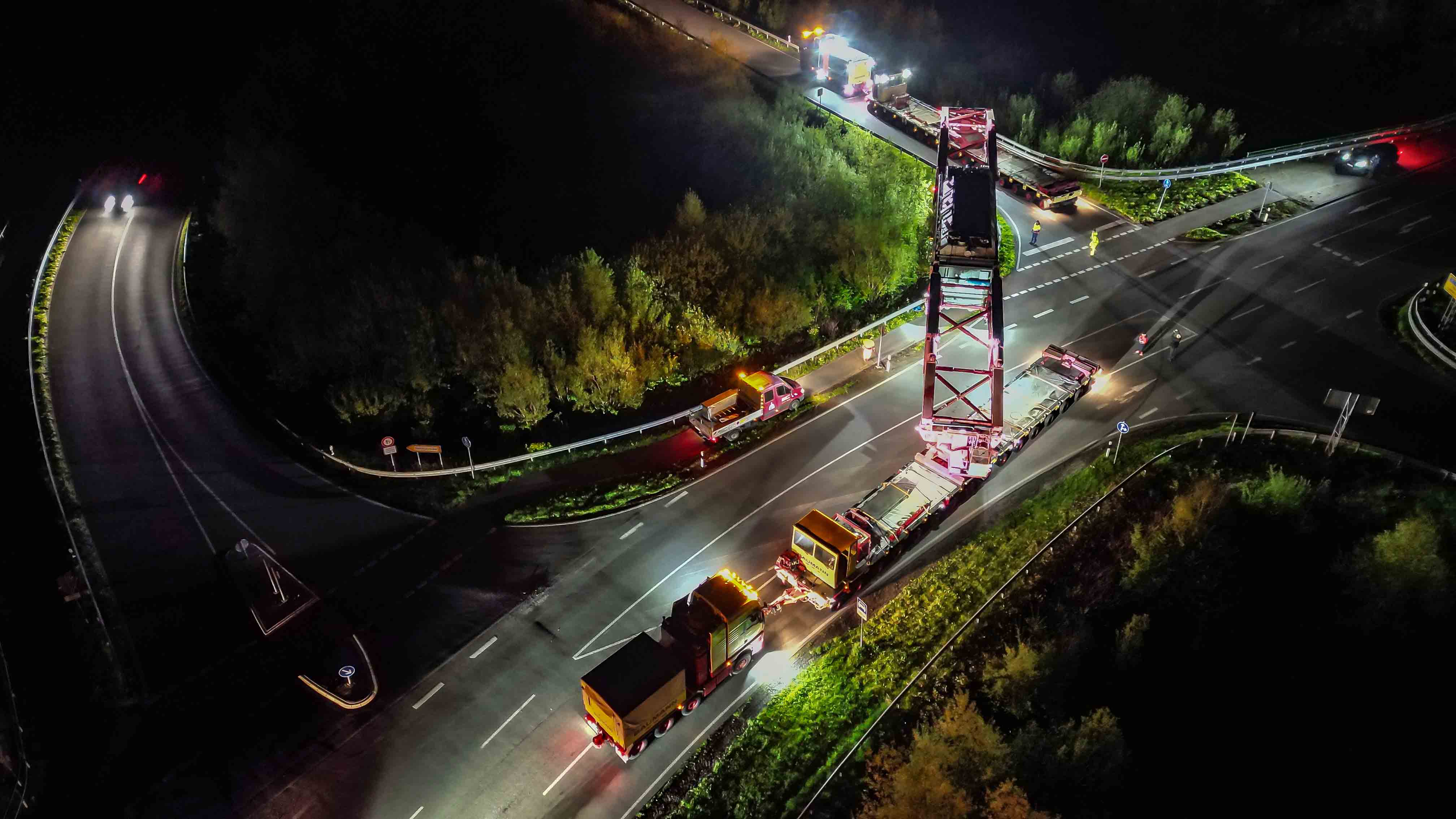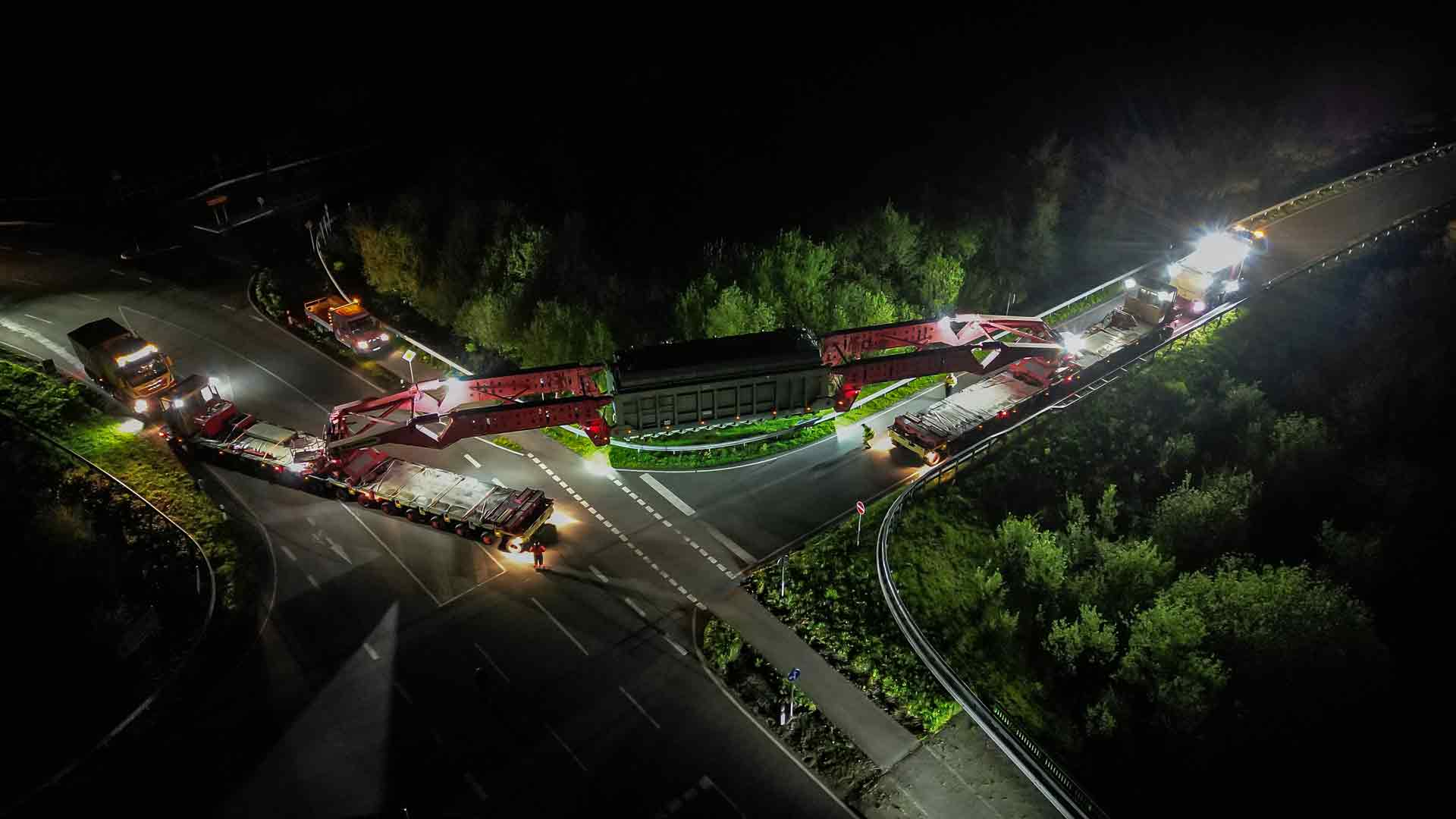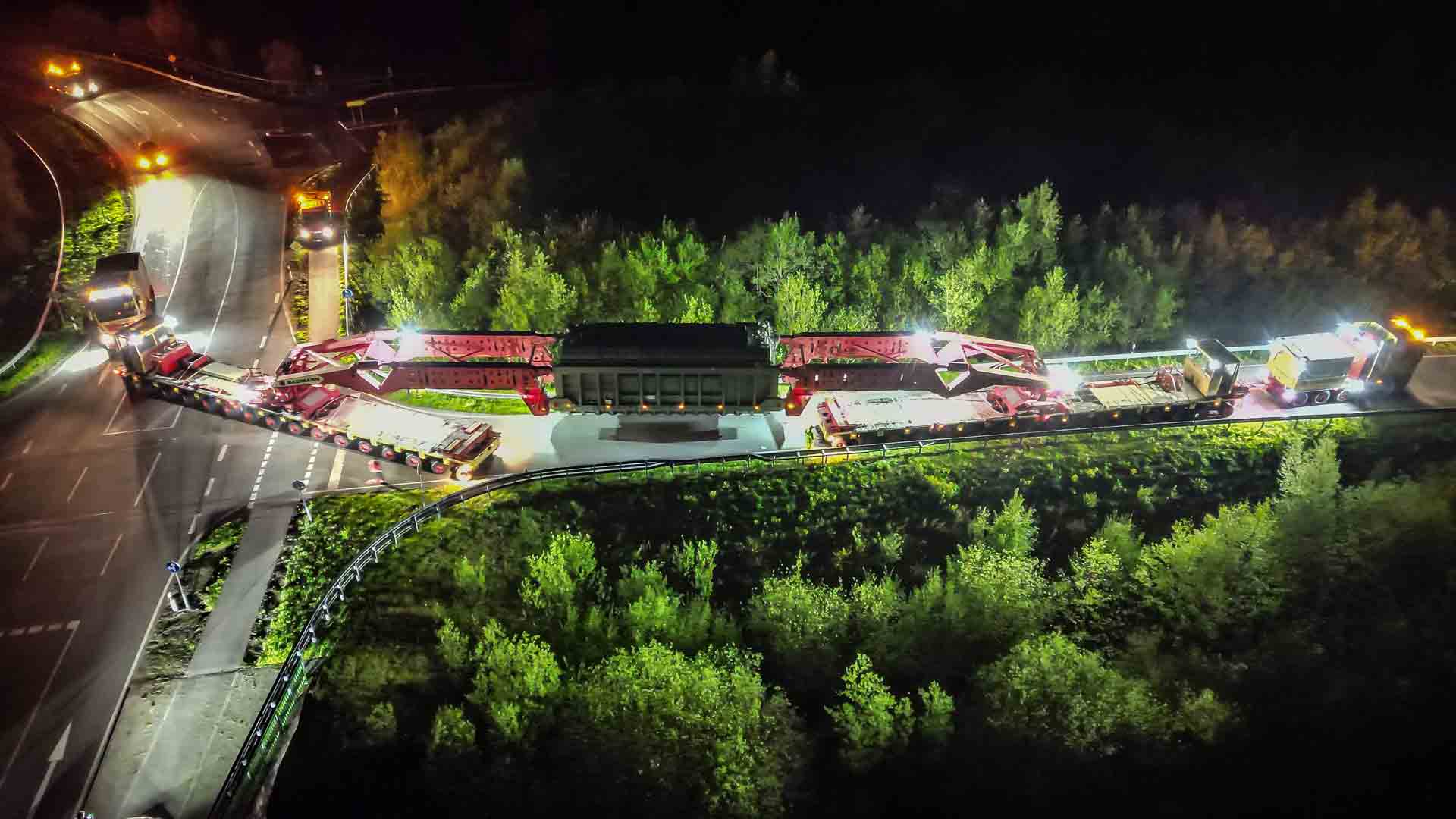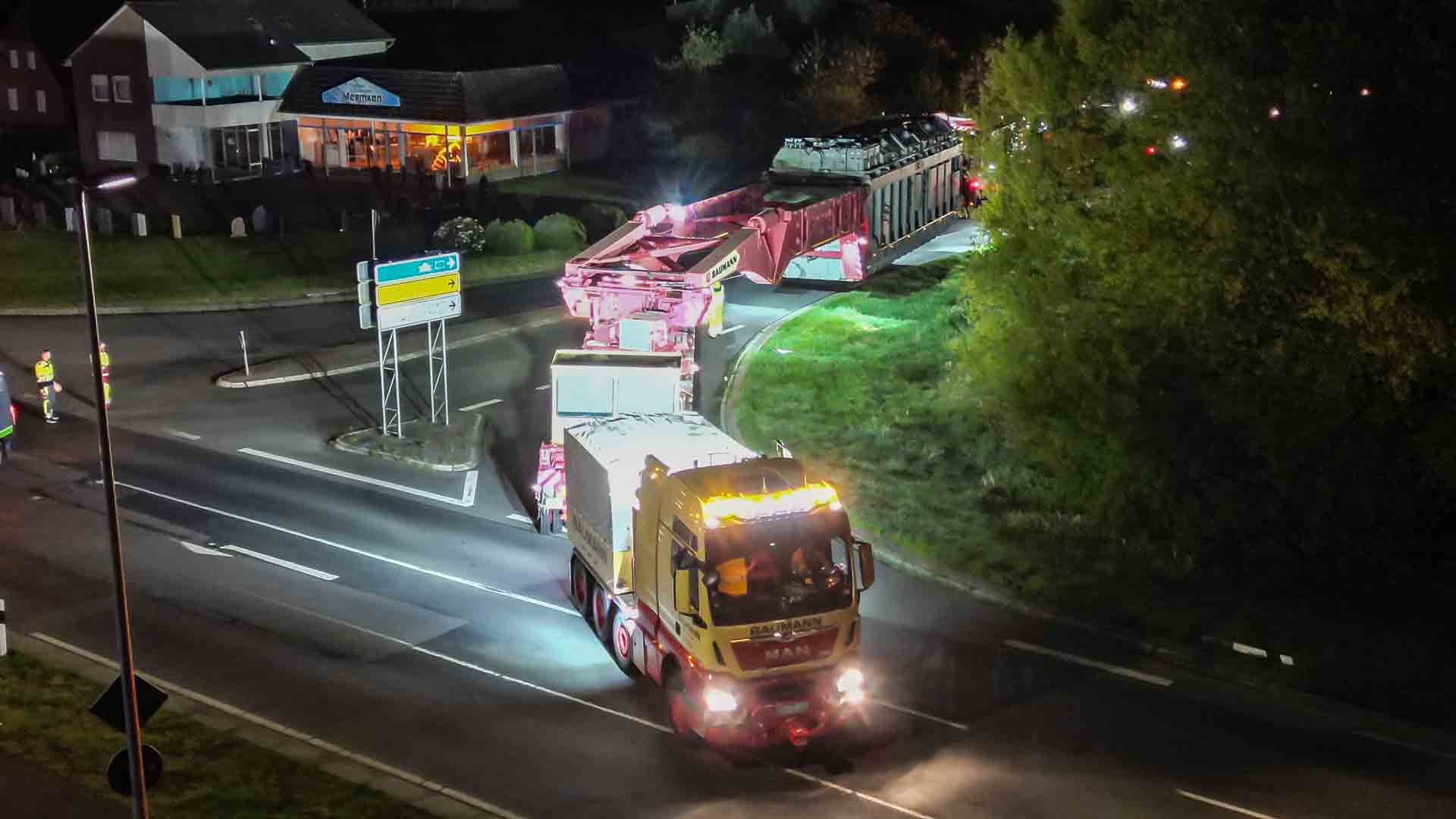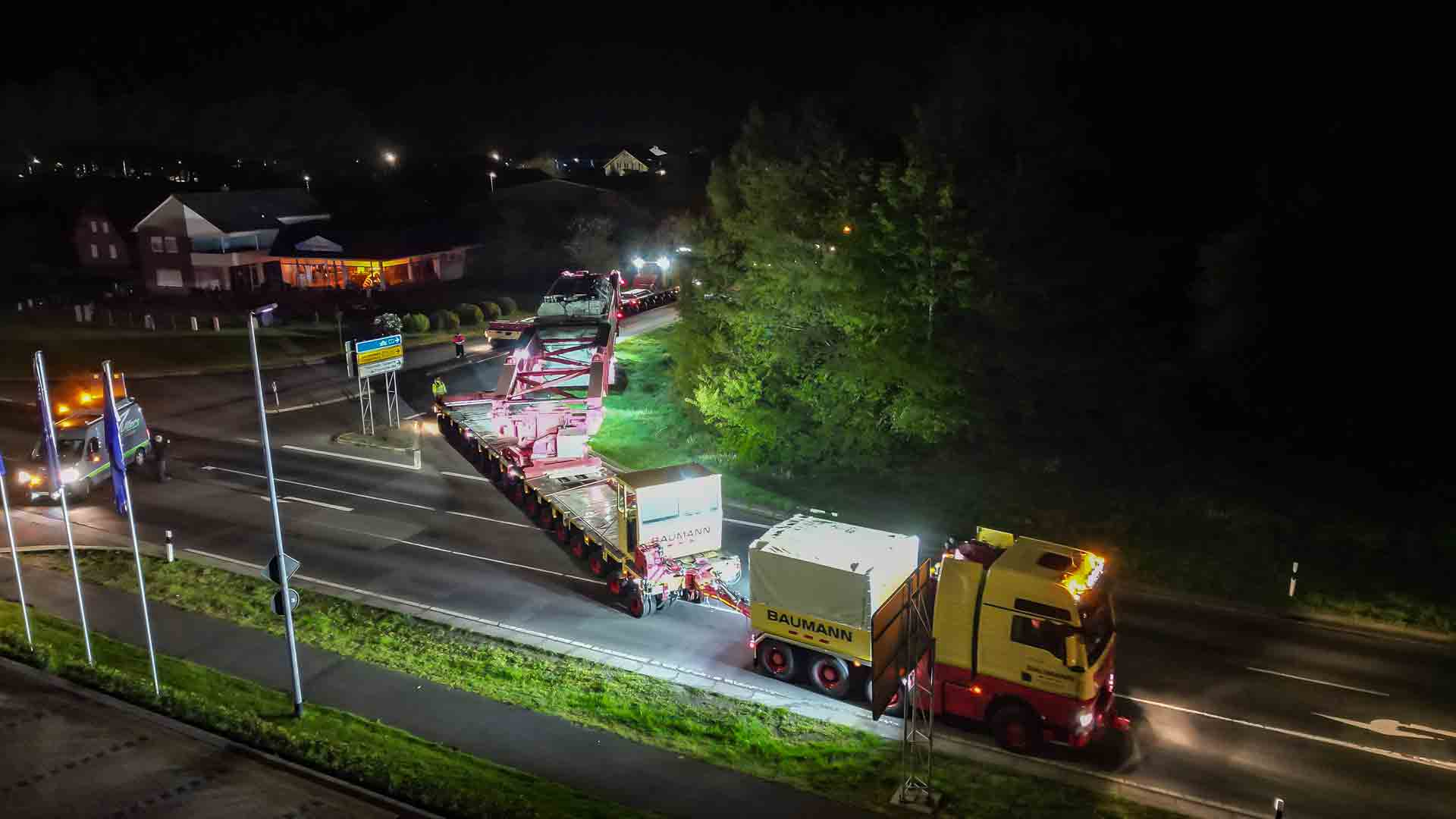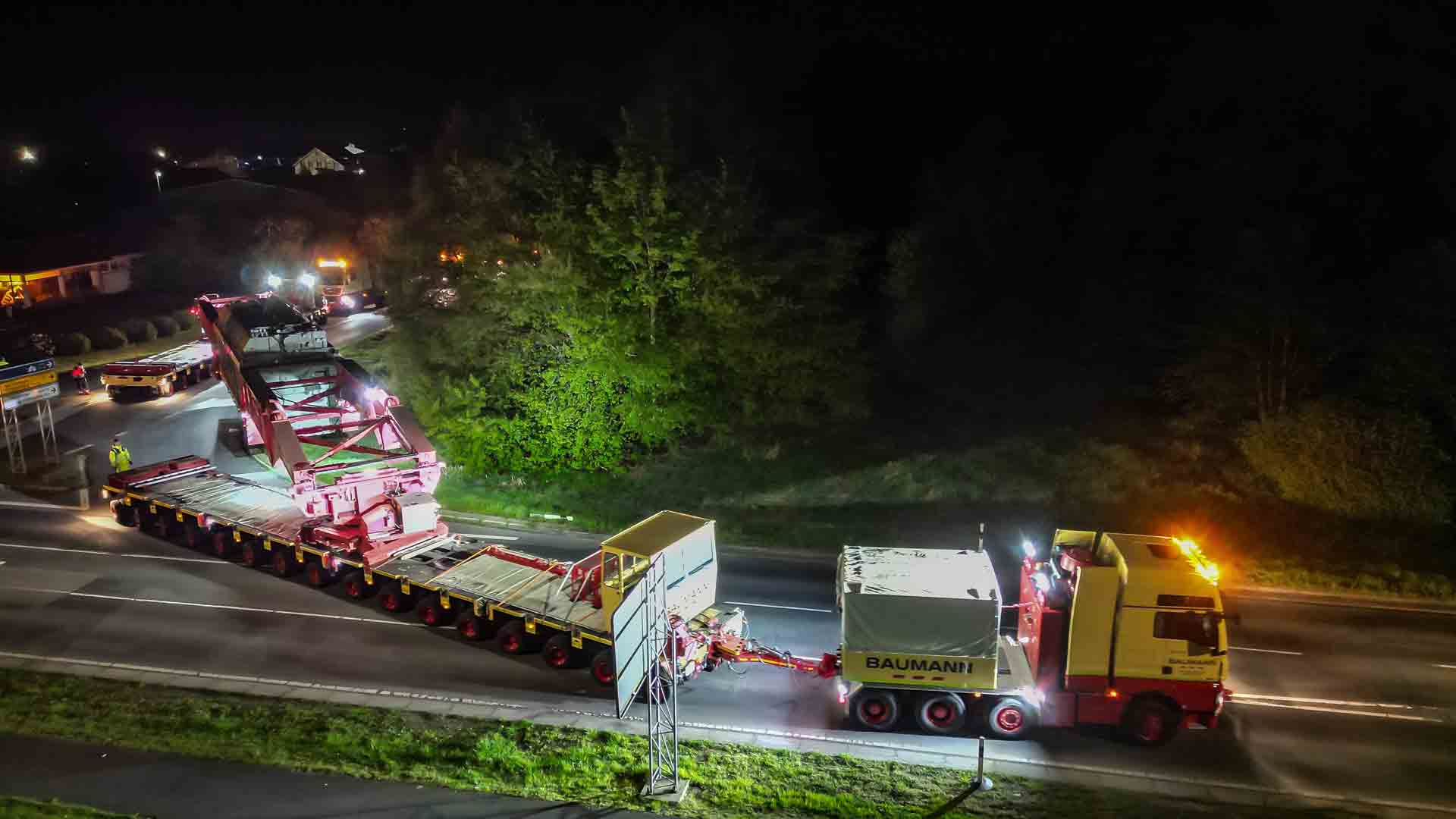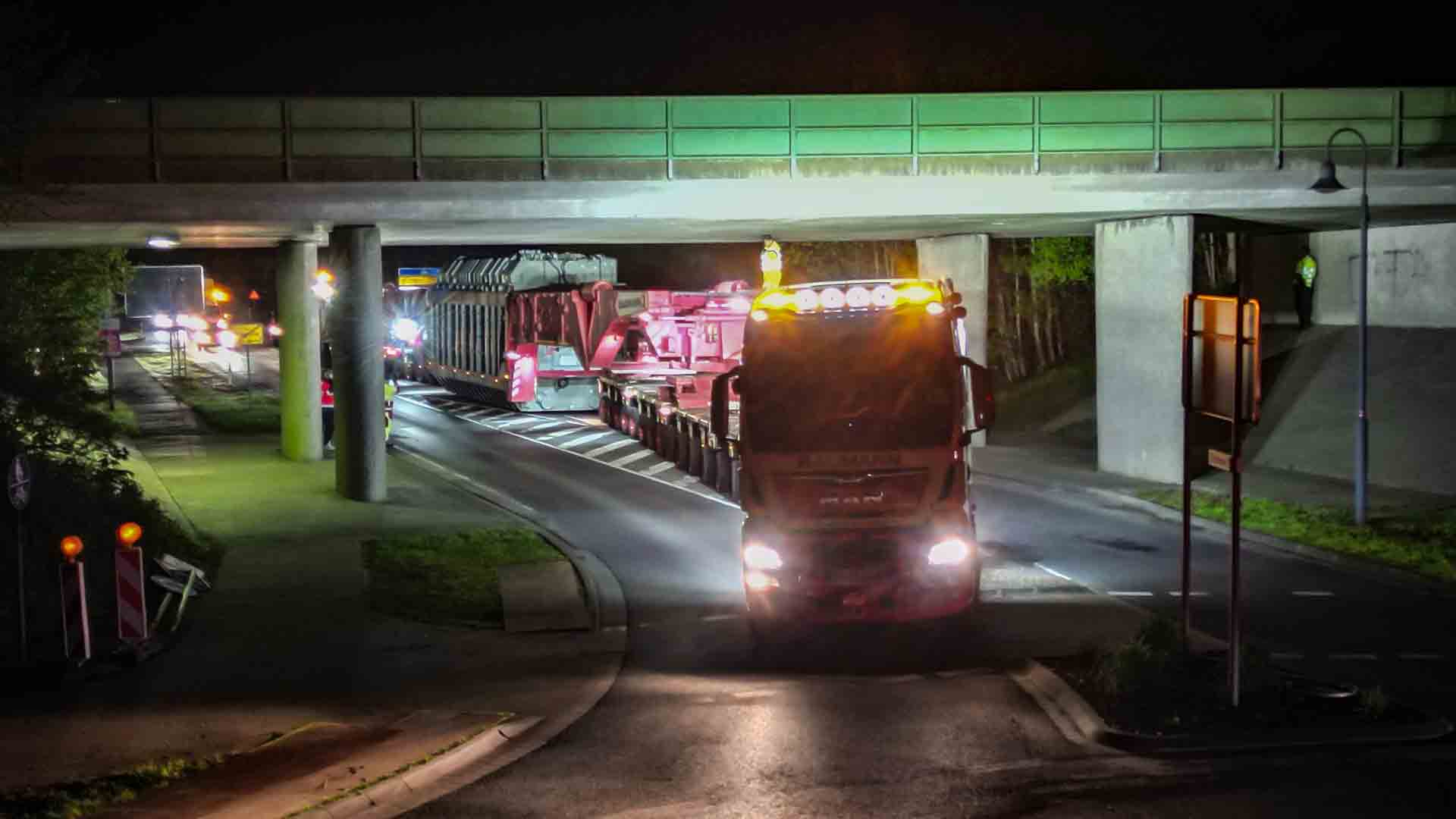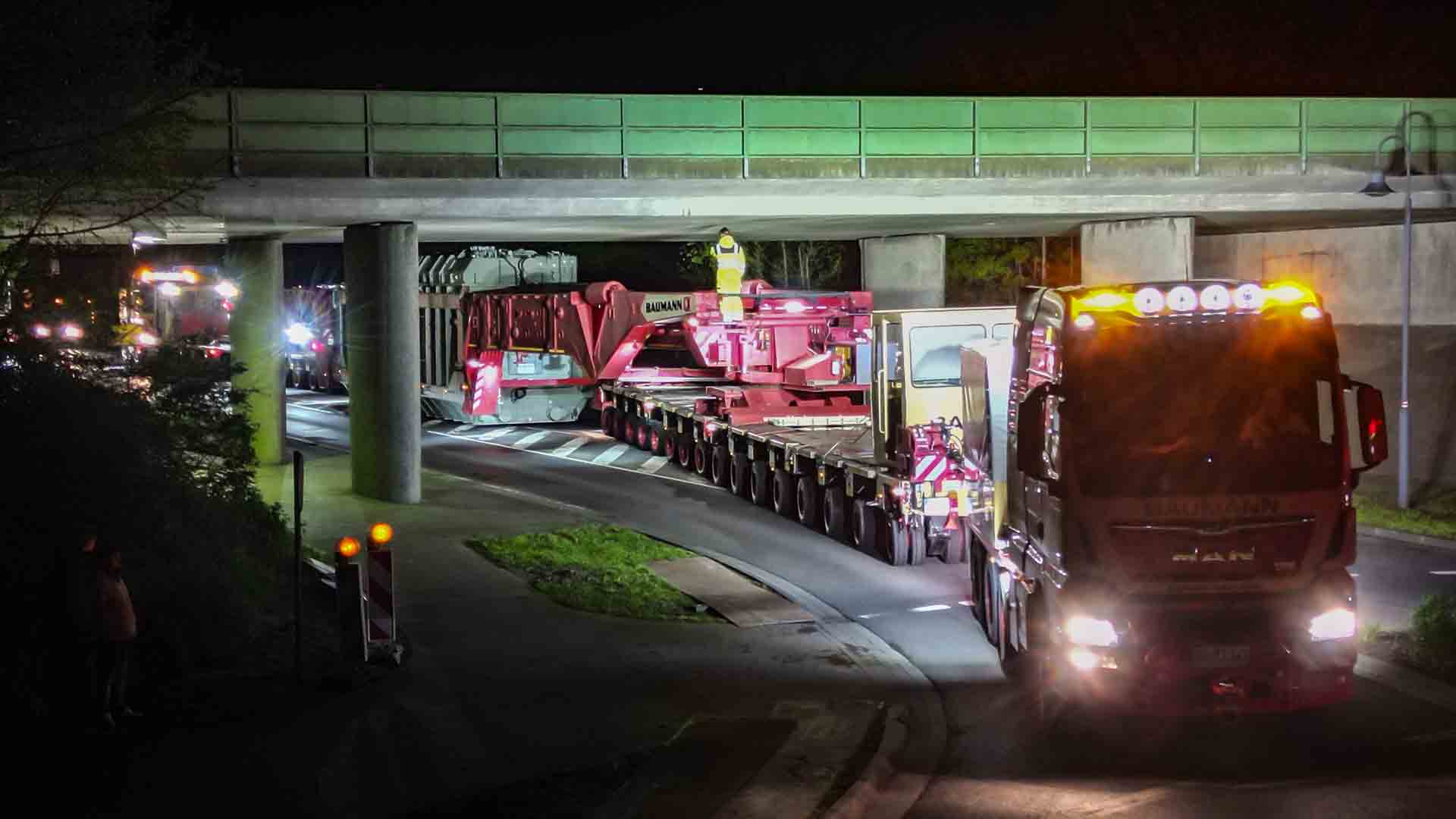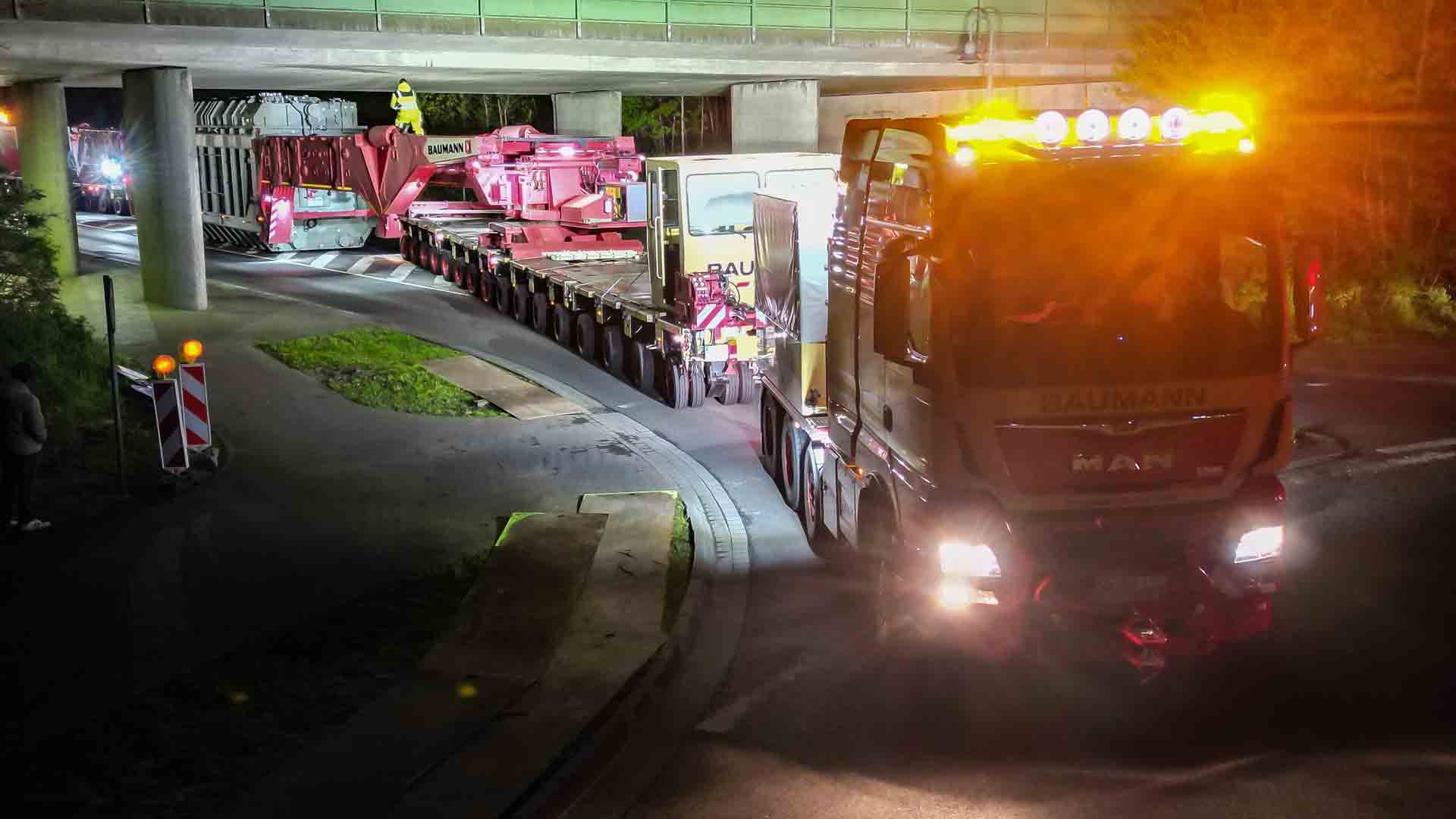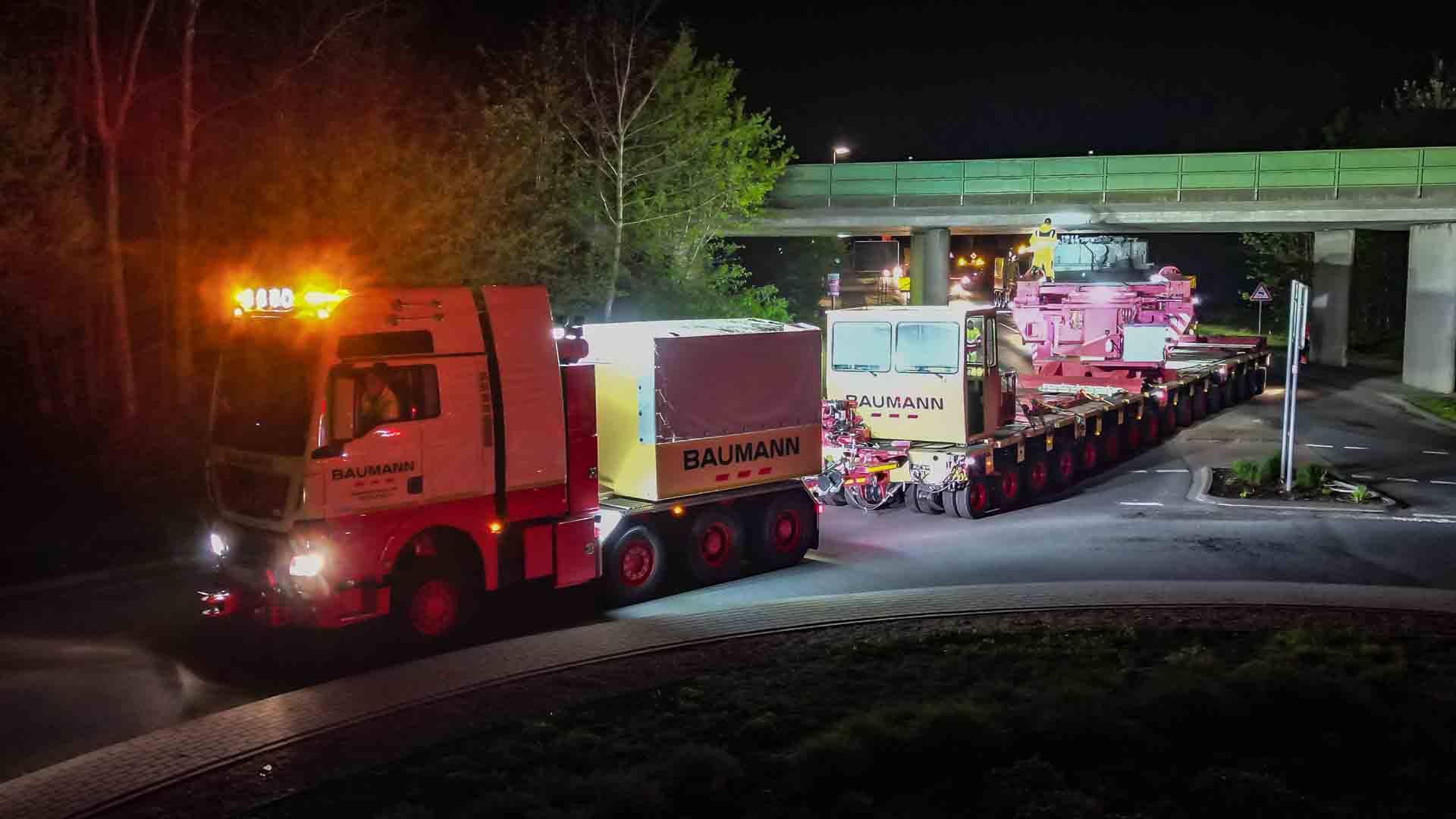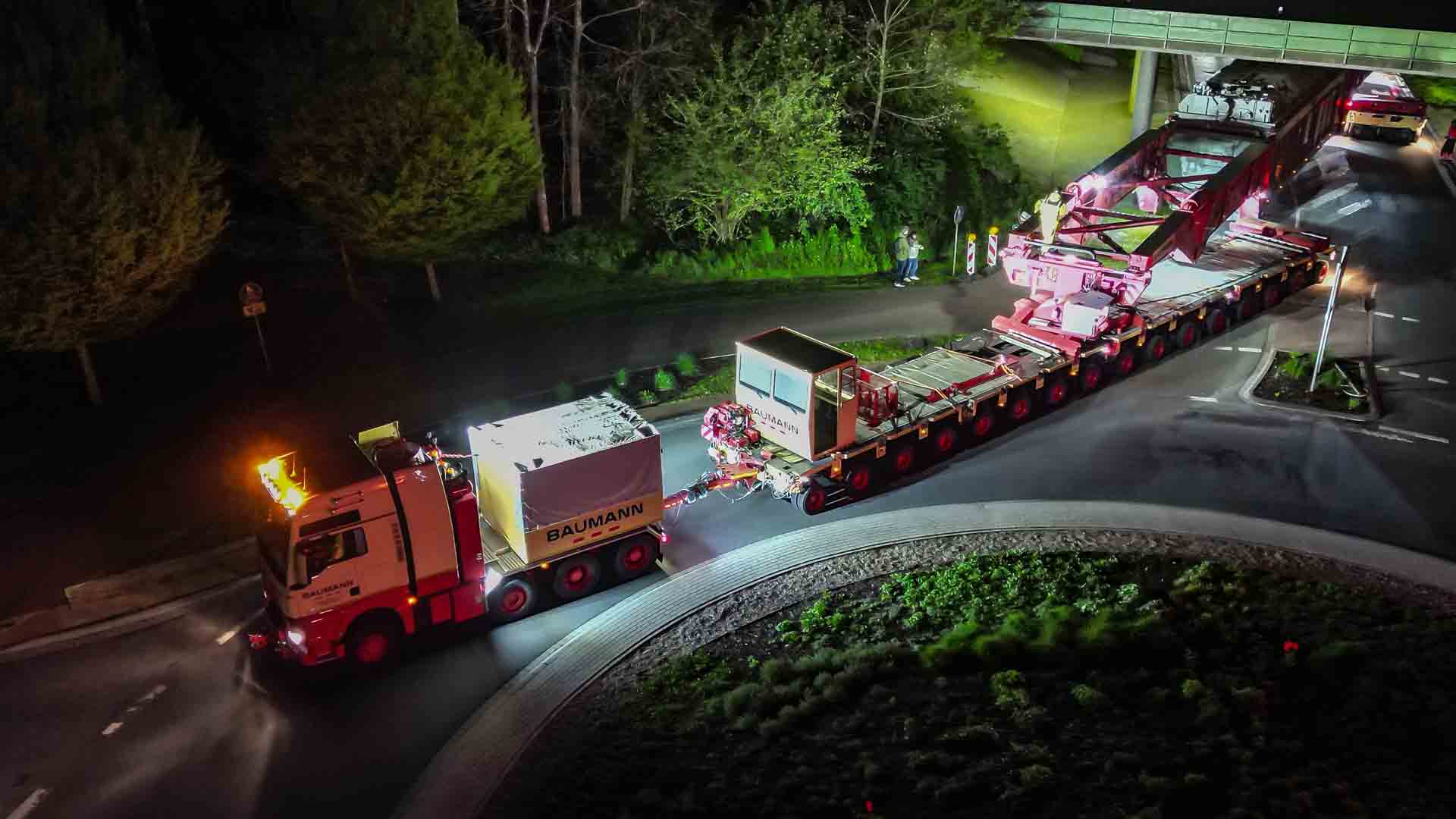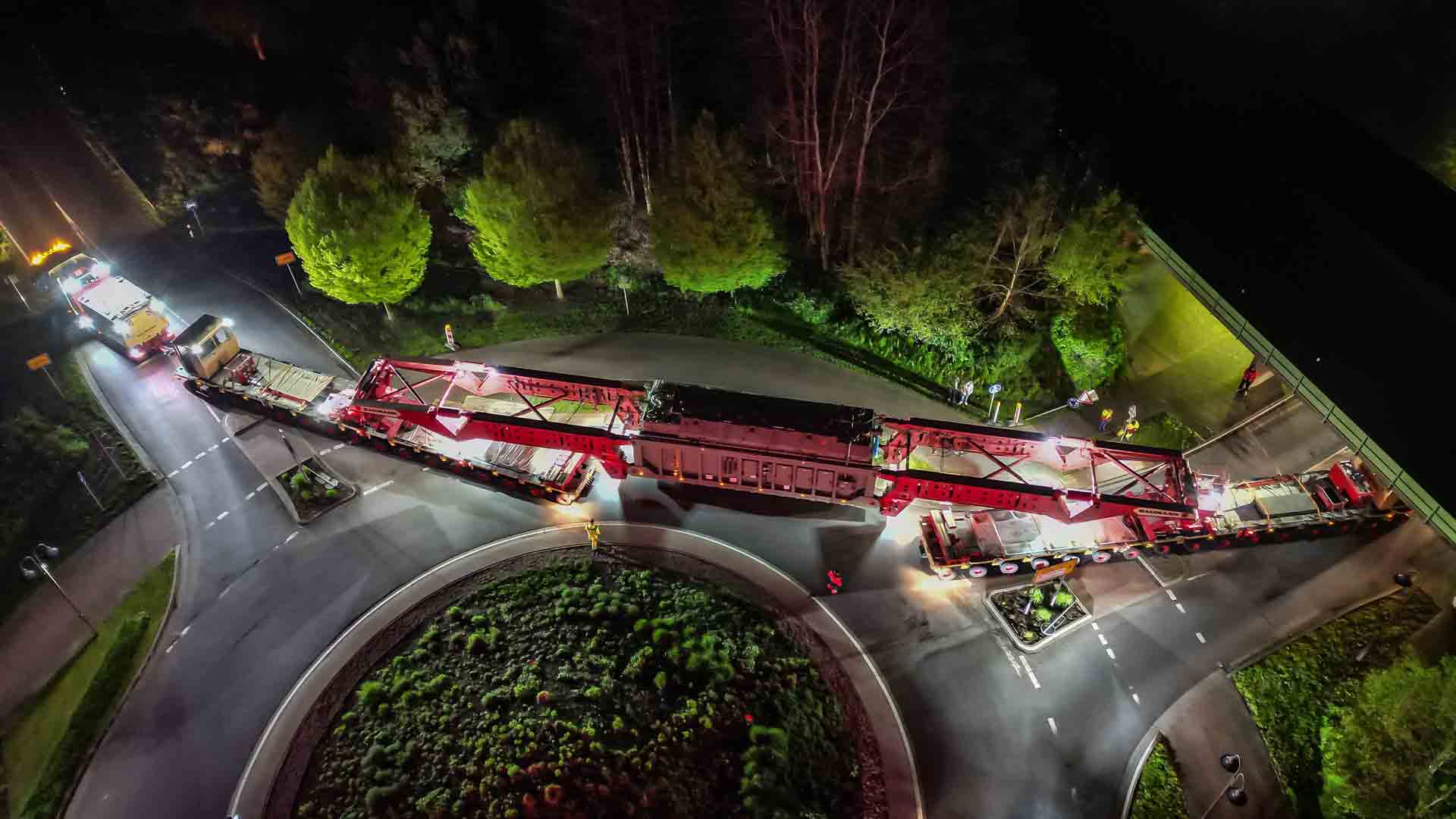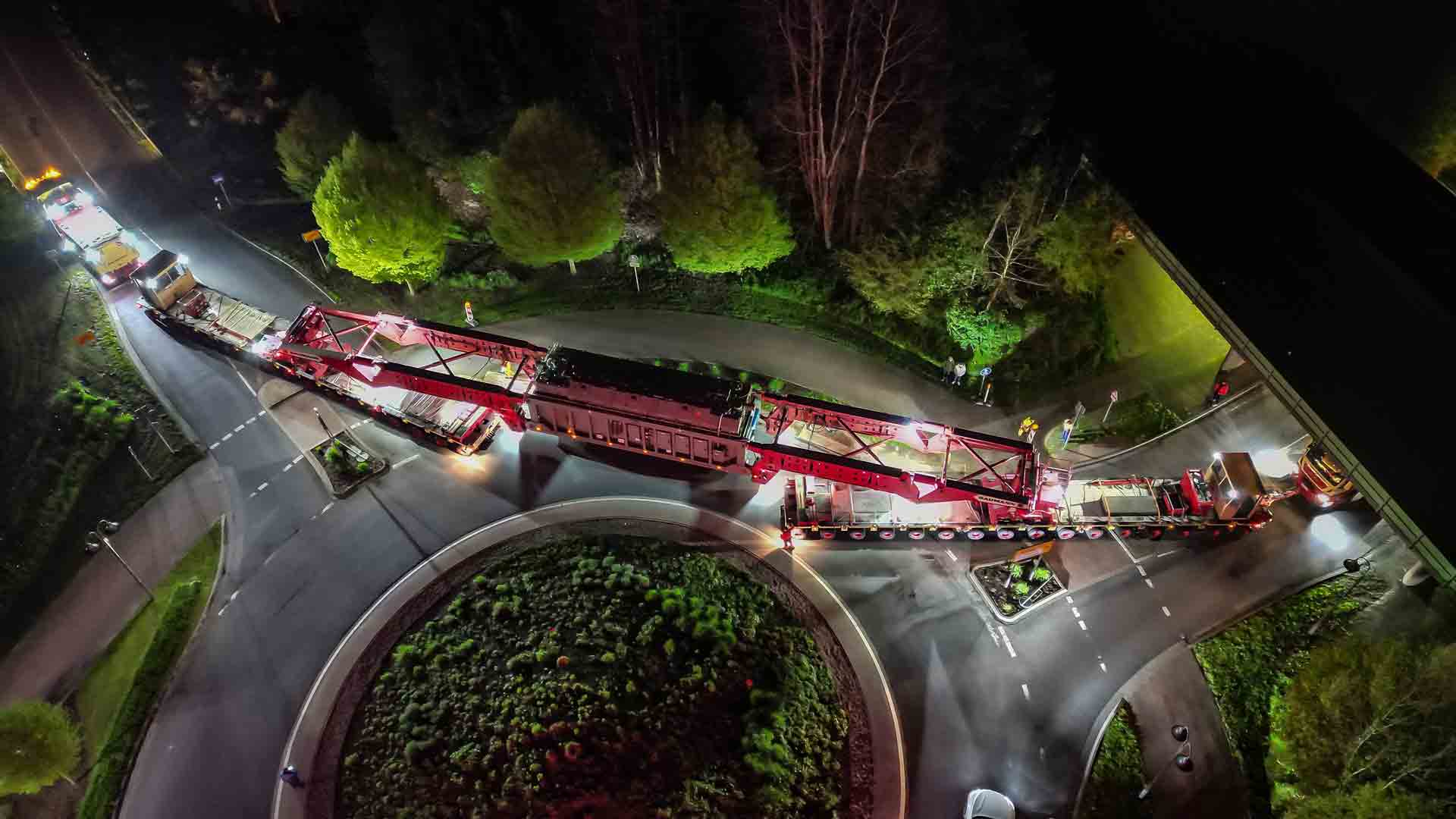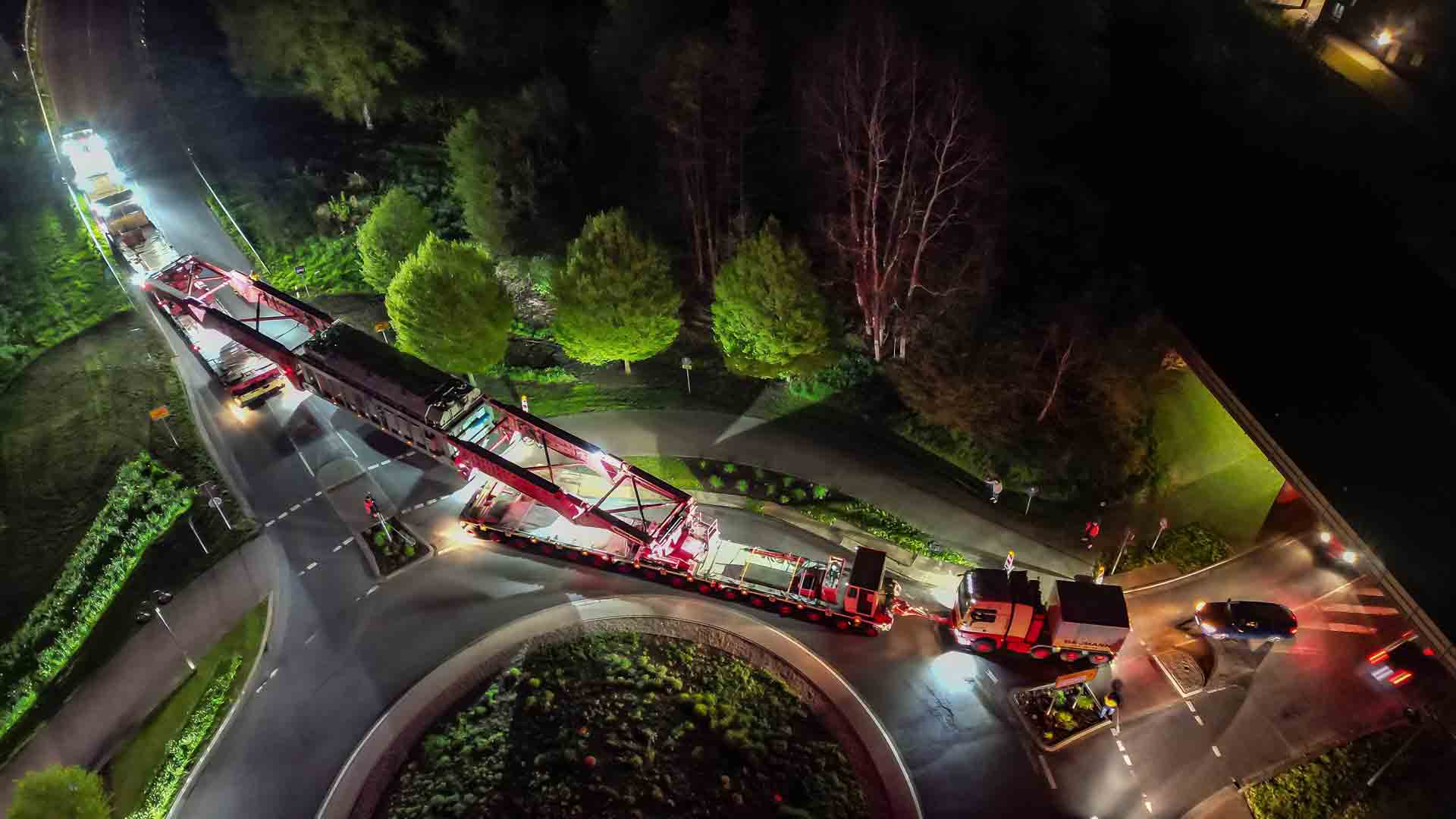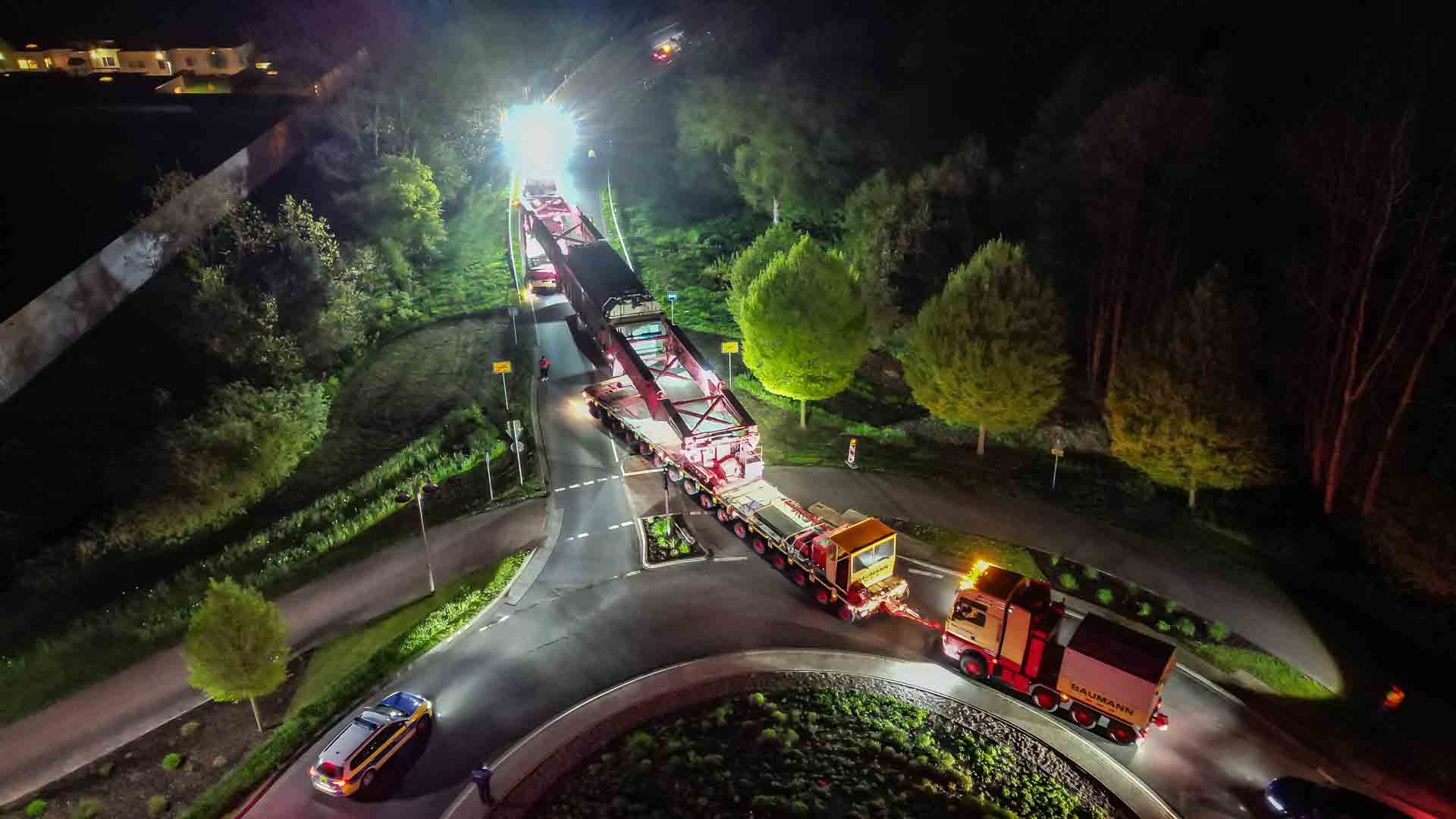On behalf of the energy transition
The trading estate c-Port Saterland/Sedelsberg is located on the Küstenkanal (coastal canal) which passes through the southwest of Oldenburg. Transformers enabling Germany’s transition to renewable energy are delivered here by ship several times a year, to be then distributed to the surrounding substations and transformer stations. Their journey is thus usually completed by specialized transport companies. Jens Hadel accompanied the delivery of a 236-ton transformer to the Garrel-Ost substation
A strong quay wall and spacious working areas make for the perfect handling location for this unusual cargo. Loading is carried out by one or two powerful mobile cranes. Once the 236-tonne transformer from Bad Honnef goes ashore, the team from Viktor Baumann's forwarding company spends the rest of the day suspending the load between the two modular trailer units. To ensure that the roads on route are not damaged by the transport’s weight, a maximum axle load of 12 tons is specified. Indeed, each of the two trailers has 16 axles with 8 wheels each. Providing the necessary grunt are two MAN TGX 41.640 tractor units. At vehicle manufacturer Toni Maurer, a total of 3 Baumann rigs have been fitted with a driven front axle, rated to a maximum total towing load of 500 tons. One unit pulls the approximately 87-metre-long trailer combination, while the second pushes on the rear trailer.
Through the eyes of a model maker
In contrast to the usual photos showing heavy transports, this transport was photographed from a drone at several crucial points. In fact, seen from the air, many of the motifs are reminiscent of model landscapes. However, this perspective also shows that a model heavy transport can almost never be placed close enough to the edge of the road, trees, and other obstacles. As long and large as the trailers are, their loads seem to float over crash barriers, fences, and other obstacles with incredible ease.
Signs are quickly dismantled at bends and then put back up. However, the important signage must not be missing for long as this would create unclear situations for other road users. Dismantling and re-erection should therefore only take place immediately ahead of and after the transport passes through. Interesting scenes can be recreated here, with the front or rear escort teams removing all traffic signs, crash barriers and lights or moving them back to their original position.
Setting off at night
In the Emsland district, heavy goods vehicles are no longer escorted by the police. Here, this is done by “auxiliary police officers” who are specially trained to accompany heavy goods vehicles. They are supported by BF3-licensed escort drivers. At 10 p.m. on the dot, the auxiliary police officers set off to completely close to traffic the first, approximately 1.5-kilometer section of two-lane Friesoyther Straße. A short time later, the long Baumann truck and trailer leaves c-Port heading east. There is no street lighting on the entire stretch of road. Even the junction area with the on and off ramps to the B72 federal road is completely unlit. However, from the air, you can see that the transport’s own lighting doesn’t just illuminate the trucks, but that even the surrounding area seems as bright as day. For the escort crew, the good view of the load and possible obstacles makes it much easier to instruct and warn the two drivers in advance. Normally, there’s no need for anyone to walk around with a flashlight to make sure there is no unintentional contact.
The first bottleneck
To get onto the B72, the heavy goods vehicle cannot take the prescribed route for other road users, over the bridge and then under it. The high gross weight makes it impossible to cross the bridge. For this reason, the accompanying auxiliary police officers temporarily block off the two westbound lanes and the exit. A short time later, the MAN TGX 41.640 tractor unit turns onto the exit, against the signposted direction of travel, and uses it as an access road to the B72. The trailer combination and transformer swing far into the lower-lying inner curve. At very slow speed, the bed simply floats over crash barriers, bushes, and trees onto the narrow connecting road. The combination stops again and again, because sometimes several escort personnel are required to push individual trees aside. This is all done carefully and calmly - they have overcome such challenges together many times. The rear trailer is then pushed onward by the second four-axle tractor vehicle and steered safely onto the access ramp by a “tree man” walking behind with a radio remote control. In the meantime, the auxiliary police have completely closed the main road so that the combination trailer and trucks can move onto their two assigned lanes. This is followed by around 3.9 kilometers of relatively speedy driving after which the next challenge awaits.
Going under not over
Arriving in Friesoythe, the next bridge problem arises. Although the route still includes several kilometers on the B72, the transport has to exit the road near the town center. The exit, which is now closed to other road users, is taken in the usual way. The route then heads towards the underpass. In front of the bridge, the attendants race around the load and measure the bridge clearance and the transport height several times, because every centimeter counts here. With a load height of 4.58 meters, there is very little room to get to the other side. Once everything is correctly adjusted and aligned, the trailer slowly rolls under the bridge. Shortly before the transformer disappears under the B72, all the attendants take another close look to make sure that the safe clearance really does apply everywhere. After the OK is given, the drivers of the two four-axle vehicles carefully accelerate, and the transport rolls under the B72 bridge very slowly. When the load has reached the middle, the combination halts to realign the load. As a normal driver, you sometimes feel the kinks in a road but probably think nothing of it. But as the minimum available distance to any ceiling decreases, it's a different story. Everyone is probably familiar with this feeling negotiating tight entrances and ramps at parking garages, where only a few centimeters decide between expensive body repairs and happy motoring.
Monitoring during the transport
For some time now, transformers and other large technical devices have been equipped with internal sensors that record “enemy contact”, i.e. contact with obstacles and any resulting deceleration. The reason is quite simple: in the event of unintentional contact, the deceleration forces are recorded because cooling lines or other technical equipment could break or start to vibrate and be damaged. Should a sudden braking effect occur during transportation due to ground contact, this could impair the transformer’s functionality. Once at the destination, data from these sensors is analyzed to check whether things really did go so smoothly.
Back on the highway
After the bridge, we take a round-about against the usual direction of travel, which we leave at the first exit. With the tractor unit already pointing towards the access ramp, members of the escort team have to take another close look. The ascent is not without its difficulties for this long worm on wheels, as the modular trailer is also rising and bridge clearance decreasing. But by adjusting height compensation, it’s a snug fit here too. Then it's back onto the B72, taking up all the lanes momentarily, but then on to Varrelbusch on the dual carriageway. Here, the two MAN TGX 41.640s are disengaged and swap places on the 16-axle trailer combination. The reason is the load will travel in the opposite direction for the last few kilometers. These “load turns” have been figured in, because at the transformer station, it does matter which transformer side is which. All the supply lines have long been positioned during construction and cannot simply be re-laid. If the transformer were delivered the other way around, it would have to be rotated somehow, and to suggest putting someone on each corner giving his or her all would not be of help in this case
At the destination
The Garrel / Ost substation is reached before sunrise and, thanks to some perfect planning, setting down and pushing the transformer into its final position is no problem. After filling it with the oil, used as a coolant, it can be connected to the power grid. By the time this is done, however, the specialized Baumann vehicles will be long gone.
Text & Photos:
Jens HadelFacts and figures
Tractor trucks:
- 2 x MAN TGX 41.640 8x6/4 with offset frame so that the engine fits between the driven front axle and the raised cab.
- 2 of the 3 special conversions for Baumann by Toni Maurer GmbH & Co KG in Türkheim
- Permitted total towing load per tractor unit: 500 tons
- With two towing vehicles and one pushing vehicle, the total towing weight is rated at 1,002 tons
- In the Baumann fleet since summer 2019
- Further units have since been built for other companies
Trailers: 2 x 16 Goldhofer-Achsen
- Front: 16 axles in 4 x 4 axle modules
- Rear: 16 axles in 2 x 6 axle & 1 x 4 axle modules
- Greiner flat-bed trailer with height-adjustable load supports
- Driving distance from c-Port to Garrel-Ost substation: approx. 35 kilometers, duration approx. 4 hours
Transformer manufacturer: Hitachi
- 236 tons empty weight (oil for temperature regulation is added on site)
- Dimensions: 12.730 x 3.95 x 4.58 m (L x W x H)

